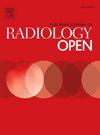Preoperative MR - based model for predicting prognosis in patients with intracranial extraventricular ependymoma
IF 2.9
Q3 RADIOLOGY, NUCLEAR MEDICINE & MEDICAL IMAGING
引用次数: 0
Abstract
Objectives
To develop and validate a prediction model based on brain MRI features to predict disease-free survival (DFS) and overall survival (OS) for patients with intracranial extraventricular ependymoma (IEE).
Methods
The study included 114 patients with pathology-proven IEE, of whom 80 were randomly assigned to a training group and 34 to a validation group. Preoperative brain MRI images were assessed with the Visually AcceSAble Rembrandt Images (VASARI) feature set. Clinical variables were assessed including age, gender, KPS, pathological grade of the tumor and blood test data such as eosinophil, blood urea nitrogen and serum creatinine. Multivariate Cox proportional hazards regression analysis was performed to select the independent prognostic factors for DFS and OS. Three prediction models were built with clinical variables, MRI-VASARI features, and combined clinical and MRI-VASARI data, respectively. The predictive power of survival models was assessed using c-index and calibration curve.
Results
Clinical variables such as eosinophil, blood urea nitrogen and serum creatinine, and MRI-VASARI feature for definition of the non-enhancing margin (F13) were significantly correlated with the prognosis of DFS. Blood urea nitrogen, D-dimer, tumor location (F1), eloquent brain (F3), and T1/FLAIR ratio (F10) were independent predictors of OS. Based on these factors, prediction models were constructed. The concordance indices of the three survival models for OS were 0.732, 0.729, and 0.768, respectively. For DFS, the concordance indices were respectively 0.694, 0.576, and 0.714.
Conclusion
Predictive modelling combining both clinical and MRI-VASARI features is robust and may assist in the assessment of prognosis in patients with IEE.
颅内室外室管膜瘤的术前MR预测预后模型
目的建立并验证一种基于脑MRI特征的预测模型,用于预测颅内室外室管膜瘤(IEE)患者的无病生存期(DFS)和总生存期(OS)。方法114例经病理证实的IEE患者随机分为训练组80例,验证组34例。术前脑MRI图像使用视觉可访问伦勃朗图像(VASARI)特征集进行评估。临床变量包括年龄、性别、KPS、肿瘤病理分级及嗜酸性粒细胞、尿素氮、血清肌酐等血检数据。采用多因素Cox比例风险回归分析选择影响DFS和OS的独立预后因素。分别用临床变量、MRI-VASARI特征、临床和MRI-VASARI数据联合建立3个预测模型。采用c指数和校准曲线评估生存模型的预测能力。结果嗜酸性粒细胞、血尿素氮、血清肌酐等临床指标及MRI-VASARI特征定义的非增强边界(F13)与DFS的预后显著相关。血尿素氮、d -二聚体、肿瘤位置(F1)、雄辩脑(F3)和T1/FLAIR比(F10)是OS的独立预测因子。基于这些因素,构建了预测模型。3种生存模型OS的一致性指数分别为0.732、0.729和0.768。DFS的一致性指数分别为0.694、0.576和0.714。结论结合临床和MRI-VASARI特征的预测模型是可靠的,可以帮助评估IEE患者的预后。
本文章由计算机程序翻译,如有差异,请以英文原文为准。
求助全文
约1分钟内获得全文
求助全文
来源期刊

European Journal of Radiology Open
Medicine-Radiology, Nuclear Medicine and Imaging
CiteScore
4.10
自引率
5.00%
发文量
55
审稿时长
51 days
 求助内容:
求助内容: 应助结果提醒方式:
应助结果提醒方式:


